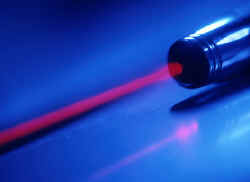How to Catch a Moonbeam

When you read this story on the web, an electronic series of 0’s and 1’s streams over the Internet and into your computer. A quantum computer network would work in much the same way, except that the well-defined bit values would be replaced by delicate combinations of quantum states. Since they are fast and durable, photons are many physicists’ first choice to be the flying quantum bits (qubits) of such a future network, but they also have drawbacks. How do you stop a photon once it arrives at your computer? In the 1 May PRL a team proposes a solution: Catch it with atoms that remember the exact quantum state of the original photon.
Although that solution sounds simple, it isn’t. Bits of information can be imprinted on a moving photon by changing the photon’s polarization from horizontal to vertical, for example. But transferring that information back into a stationary computer is very difficult; most clues to the photon’s original state are destroyed when the photon is absorbed by an ordinary atom. Now Mikhail Lukin, Susanne Yelin, and Michael Fleischhauer of the Harvard-Smithsonian Center for Astrophysics in Cambridge, MA, have proposed using a little quantum trickery to save the photon’s state.
In the last decade, physicists have discovered a way to slow photons down to the speed of a bicycle. The photons are injected into a cavity containing a laser-irradiated atomic gas. The laser light is tuned to a special frequency that changes the quantum state of the atoms in a way that prevents them from absorbing the photons. Instead, the laser-excited atoms in the gas cluster around the photons, forming new quasiparticles called polaritons. Dragged down by the additional mass of the atoms, the photons slow to a crawl.
Now here is the trick. The velocity of a polariton is proportional to the laser beam intensity. As the beam intensity falls, more atoms try to grab onto fewer photons, raising the total polariton mass and reducing its velocity. “If we reduce the intensity of the laser beam to zero after the pulse goes in,” says Lukin, “the velocity of the polariton goes to zero and so does the number of photons in it. The polariton becomes purely atomic.” By catching the polariton, the team argues, they would also trap the quantum state of the original photon. “The photon’s quantum state is copied to the atoms reversibly and coherently,” says Lukin.
Other groups are trying to trap photons with single atoms isolated in a cavity, but keeping one atom in a cavity and hitting it with a single photon is hard, says Atac Imamoglou of the University of California in Santa Barbara. He believes that the simpler method proposed by Lukin and his colleagues is a major improvement. “The technology is already there,” says Imamoglou. Lukin’s team hopes to demonstrate the technique within a few months.
–Mark Sincell
Mark Sincell is a freelance science writer based in Houston, TX.


